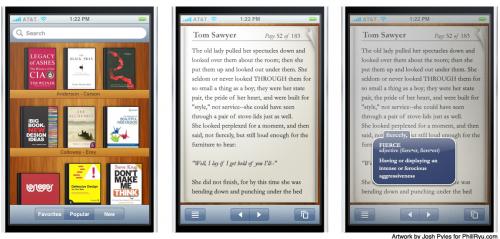A different eReading related offering from CES - eReading Software for your PC. A change after seeing so many eReaders announced.
This software is available for buying, organizing and reading your eBook content on PC and Mac.
Interesting to link in additional content from the web, which seems nicely integrated into the "book".
I don't think such software can be built only on having a nice UI and a "snazzy" (as Engadget put it) 3D reading mode, with animated page turns. Those gimmicks can quickly ware off, and even get in the way of really "getting into your book". Personally, I'd go for the "invisible user interface" approach, where you don't even realize there IS a user interface, just a book which you quickly dive into.
The utility of this software, over either using nothing, or the PC software that comes with an eReader you buy will depend a lot on the type of reading you do and where it will be done.
Reading on a laptop (which I have tried) is subject to all my usual gripes:
- power up time
- form factor, keyboard in the way
- heat generated
- size and weight
- short battery life, both while reading and in any "fast-boot sleep state"
One area where a PC can excel at the moment is in showing high-color, interactive material, where it ceases to be an eBook and becomes something new. If the right content is produced to take advantage of this, and the UI works, then it could lead to new types of "books", reading and education.
With recent and expected developments in display technologies (PixelQi, Mirasol, LiquaVista) we may see that ability coming to eReaders too, or a convergence between eReaders and tablets and PMPs and laptops - depending on how you prefer to view that.
Off one thing going for a PC, is the fact that you maybe carrying it anyway! With the small additional weight new eReaders represent, I take my eReader anyway - PC or not, just like I'd take a paper book - PC or not.
From Engadget coverage at http://www.engadget.com/2010/01/06/blio-e-reader-software-hands-on/ (short video included)






